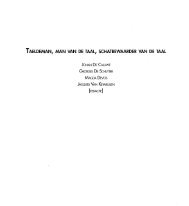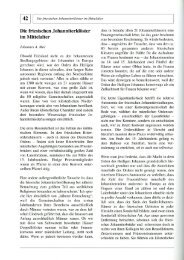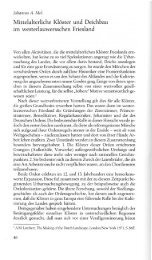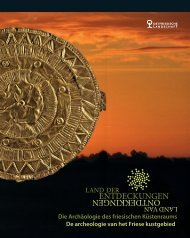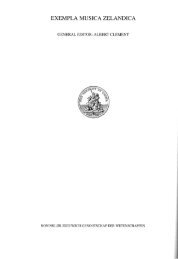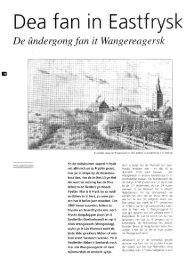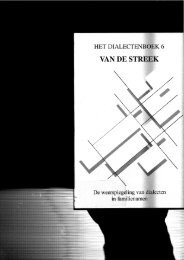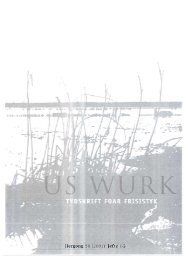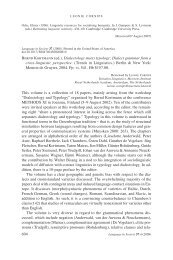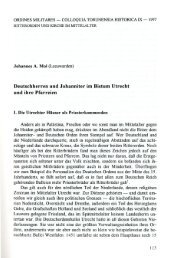Antropologen, historici en de hartslag van het archief
Antropologen, historici en de hartslag van het archief
Antropologen, historici en de hartslag van het archief
You also want an ePaper? Increase the reach of your titles
YUMPU automatically turns print PDFs into web optimized ePapers that Google loves.
<strong>Antropolog<strong>en</strong></strong>, <strong>historici</strong> <strong>en</strong> <strong>de</strong> <strong>hartslag</strong> <strong>van</strong> <strong>het</strong> <strong>archief</strong><br />
prof.dr. Herman Rood<strong>en</strong>burg - Faculteit <strong>de</strong>r Sociale Wet<strong>en</strong>schapp<strong>en</strong>
(<br />
<strong>Antropolog<strong>en</strong></strong>, <strong>historici</strong> <strong>en</strong> <strong>de</strong> harts lag <strong>van</strong> <strong>het</strong> <strong>archief</strong><br />
prof.dr. H. W. Rood<strong>en</strong>burg<br />
Re<strong>de</strong> uitgesprok<strong>en</strong> bij <strong>de</strong> aanvaarding <strong>van</strong> <strong>het</strong> ambt <strong>van</strong> bijzon<strong>de</strong>r hoogleraar<br />
Historische antropologie <strong>en</strong> etnologie <strong>van</strong> Europa, met bijzon<strong>de</strong>re aandacht<br />
voor Ne<strong>de</strong>rland, 1500 tot hed<strong>en</strong>, <strong>van</strong>wege KNAWjMeert<strong>en</strong>s Instituut bij <strong>de</strong><br />
faculteit <strong>de</strong>r Sociale wet<strong>en</strong>schapp<strong>en</strong> <strong>van</strong> <strong>de</strong> Vrije Universiteit Amsterdam<br />
op 78 september 2009.<br />
"<br />
vrije Universiteit amsterdam W
For Christi<strong>en</strong> and Daniel, and in loving memory of my par<strong>en</strong>ts<br />
2<br />
Rector, Ladies and G<strong>en</strong>tlem<strong>en</strong>,<br />
Archives are <strong>de</strong>ad. They may hold thousands or ev<strong>en</strong> millions of records, but it's all just stuff. As<br />
some Dutch burgomasters realised (or so the story goes), archives are perfect for filling up the<br />
local village ditch. And wh<strong>en</strong> building a subway - the way it was done in Cologne's medieval<br />
town c<strong>en</strong>tre - well, an <strong>en</strong>tire tunnel can be filled!<br />
Still, there is no shortage of historians who view archives in highly romantic terms. Ever<br />
since the days of Jules Michelet they dream of making the ink on parchm<strong>en</strong>t speak and, like<br />
Arlette Farge or Carolyn Steedman, they ev<strong>en</strong> write fine studies on such longings alone (Farge<br />
1989; Steedman 2001). Perhaps the most hopeless romantics (or animists, if you like) are the<br />
cultural historians, those who conceive of culture in broad, anthropological terms. Famous is the<br />
injunction of one of them, the English historian G. M. Young, 'to go on reading until you can<br />
hear people talking'. But anthropologists taking a long, historical view at culture like to animate<br />
the archive as well; for instance, the American anthropologist Ann Laura Stoler, who wrote at<br />
l<strong>en</strong>gth about the 'pulse' of the archive in her latest book on the Dutch East Indies. Scholars<br />
should learn to feel that pulse, to trace the affective strains hidd<strong>en</strong> in archival forms (Stoler<br />
2009).<br />
With anthropologists now haunting and ev<strong>en</strong> fetishising the <strong>de</strong>ad matter of archives, are<br />
there any distinctions left betwe<strong>en</strong> anthropology and history? As anthropologist W<strong>en</strong>dy James<br />
rec<strong>en</strong>tly observed, 'the question mainly in people's minds these days asks what is the differ<strong>en</strong>ce<br />
betwe<strong>en</strong> these disciplines, if any?' (James 2003: 298-99). She was certainly not the first to note<br />
the two disciplines' rapprochem<strong>en</strong>t.<br />
In the following pages I will trace some of the history of this striking converg<strong>en</strong>ce.<br />
However, knowing less about anthropology, I will not <strong>de</strong>lve <strong>de</strong>eply into Stoler's work and that of<br />
her colleagues, the historical anthropologists. Instead, I will conc<strong>en</strong>trate on the anthropological<br />
(or cultural) historians, on those who in their investigations of the everyday have consist<strong>en</strong>tly<br />
turned to social or cultural anthropology and, to a lesser <strong>de</strong>gree, to various related disciplines. 1<br />
1 I realise that the t<strong>en</strong>n 'historical anthropology' has oft<strong>en</strong> be<strong>en</strong> used to d<strong>en</strong>ote the latter category, but I prefer to<br />
keep the distinction as simple as possible. For various helpful overviews of the rapprochem<strong>en</strong>t looking mostly at the<br />
writings of anthropologists (discussing Boas, Kroeber, Bernard S. Cohn, Marshall Sahlins, Eric Wolf and many<br />
others), see Faubion 1993; Axel 2002; Dube 2007. The historical anthropology emerging in the 1970s in the<br />
Netherlands and strongly inspired by the writings of Norbert Elias still needs to be chronicled. But see Blok 1988<br />
and Blok 2001.<br />
3
affairs'. Historians should no longer continue 'to grub away in the old, empirical tradition', but<br />
rather acquaint themselves with the social sci<strong>en</strong>ces (Thomas 1966).<br />
In later years Thomas came to regret how he had couched some of his comm<strong>en</strong>ts, but not<br />
their purport. He liked to cut his own path and may have recognised a kindred spirit in E<strong>van</strong>s<br />
Pritchard, a Welshman like himself. Wh<strong>en</strong> Thomas s<strong>en</strong>t E<strong>van</strong>s-Pritchard his lecture, the latter<br />
s<strong>en</strong>t him a sardonic reply, observing that Thomas had clearly read more anthropology than he<br />
ever had. He found most of it 'totally turgid and jargon-ridd<strong>en</strong>, unreadable, I fear' (Pallares<br />
Burke 2002: 92-3).<br />
E<strong>van</strong>s-Pritchard objected primarily to the g<strong>en</strong>eration of anthropologists before him, to the<br />
functionalism of both Bronislaw Malinowski and Alfred Radcliffe-Brown, his former tutor and<br />
ev<strong>en</strong> pre<strong>de</strong>cessor in Oxford. Both had be<strong>en</strong> 'extremely hostile to history' (and yet, how can we<br />
explain Huizinga's long-standing fri<strong>en</strong>dship with Malinowski?). They were right to distance<br />
themselves from both the evolutionists and the diffusionists in anthropology, from their<br />
speculative historical observations, but that was not the main issue. This was their quest to find<br />
universal laws by which the historical <strong>de</strong>velopm<strong>en</strong>t of societies, their passing through distinct<br />
evolutionary stages, could be explained.<br />
According to E<strong>van</strong>s-Pritchard, the functionalists did exactly the wrong thing. They threw<br />
out the good part, the historical framework, keeping the bad one, the tracing of evolutionary<br />
laws. As he noted scathingly, 'The functionalist critics of both evolutionists and diffusionists<br />
should have chall<strong>en</strong>ged them, not for writing history, but for writing bad history. As it was, they<br />
dropped the history and kept the pursuit of laws, which was oft<strong>en</strong> precisely what ma<strong>de</strong> the<br />
history bad' (E<strong>van</strong>s-Pritchard 1962: 47). In other words, Malinowski and Radcliffe-Brown still<br />
conceived of anthropology as a g<strong>en</strong>eralising sci<strong>en</strong>ce to be mo<strong>de</strong>lled on the natural sci<strong>en</strong>ces,<br />
whereas E<strong>van</strong>s-Pritchard saw his discipline as an individualising sci<strong>en</strong>ce, <strong>en</strong>abling (as Thomas<br />
established in his lecture) a close and converg<strong>en</strong>t relationship betwe<strong>en</strong> history and anthropology.<br />
In their view, both historians and anthropologists should conc<strong>en</strong>trate on the study of<br />
social patterns, on un<strong>de</strong>rstanding cultures as a whole. This explains E<strong>van</strong>s-Pritchard's regard for<br />
Bloch, Febvre and other hisfori<strong>en</strong>s-socio!ogues, such as H<strong>en</strong>ri Pir<strong>en</strong>ne. 7 He could also have<br />
m<strong>en</strong>tioned Huizinga and his morphological epistemology, but the Dutch historian's star would<br />
only rise in the 1970s. Conversely, to study ph<strong>en</strong>om<strong>en</strong>a in terms of each other, not in a vacuum<br />
1 He nl80 m<strong>en</strong>tions an ol<strong>de</strong>r g<strong>en</strong>eration, with Gustave Glotz, Maitland and Paul Vinogradoff.<br />
6<br />
but always against the horizon of a prior un<strong>de</strong>rstanding of the social system as a whole, was what<br />
historians could learn from anthropologists. As Thomas conclu<strong>de</strong>d, anthropologists, more than<br />
historians, were trained to theoretically integrate the ph<strong>en</strong>om<strong>en</strong>a un<strong>de</strong>r study (Thomas 1963: 5-<br />
7).<br />
In addition, the anthropologists had their fieldwork, which in Thomas' opinion was the<br />
only basic distinction betwe<strong>en</strong> the two disciplines and anthropology's greatest asset. As he<br />
explains, 'in most cases the anthropologist did once live in, or at least visit, the society which he<br />
is <strong>de</strong>scribing, whereas the historian usually has to work exclusively from docum<strong>en</strong>ts or<br />
archaeological remains'. It gives the anthropologist 'the inestimable ad<strong>van</strong>tage of direct<br />
experi<strong>en</strong>ce of matters about which historians have only read in books'. For instance, wh<strong>en</strong> the<br />
latter stumble onto the unfamiliar in their sources, such as in cases of witchcraft, they may easily<br />
view it as something incongruous, an exotic survival of 'unreason', whereas for an<br />
anthropologist practices of witchcraft may loom large in his daily concerns (Thomas 1963: 5, 8).<br />
It was precisely such stimuli to the historical imagination that the first anthropological<br />
historians were looking for in the other discipline. The many transcontin<strong>en</strong>tal analogies betwe<strong>en</strong><br />
the 'primitive' societies examined by anthropologists and the medieval and early mo<strong>de</strong>m<br />
societies they studied themselves provi<strong>de</strong>d a welcome heuristic compass in navigating their<br />
scarce and lacunal sources. The analogies could draw their att<strong>en</strong>tion to ev<strong>en</strong> the smallest hints of<br />
larger social patterns, thus helping them to <strong>de</strong>-exoticise the past, to familiarise the unfamiliar.<br />
Among the many examples illustrating his point, Thomas inclu<strong>de</strong>d his own investigations<br />
into religion and magic in Tudor and Stuart England (Thomas 1963: 8-9). As he also explained<br />
in his acclaimed monograph on the subject, thanks to E<strong>van</strong>s-Pritchard's studies on the Azan<strong>de</strong><br />
and those of other Africanists, such as Max Marwick or Victor Turner, he came to realise how<br />
the magical beliefs among his English villagers helped to boost the community's social<br />
integration, how it str<strong>en</strong>gth<strong>en</strong>ed the traditional obligations of charity and neighbourliness. Those<br />
wishing to shirk such duties, g<strong>en</strong>erally the nouveaux riches profiting from the period's economic<br />
differ<strong>en</strong>tiation, still feared the magical power of the indig<strong>en</strong>t who came begging at their doors.<br />
With their spells these beggars might harm their health, crops or cattle (Thomas 1971 a; cf.<br />
Thomas 1971b). As Thomas points out, many such comparisons could be drawn (and not only<br />
with sub-Saharan cultures), all amplifYing the historian's historical imagination. Conversely,<br />
Africanists working on witchcraft welcomed the cultural historians and their global approach.<br />
7
Wh<strong>en</strong> E<strong>van</strong>s-Pritchard retired in 1968, both Thomas and his stud<strong>en</strong>1;. Alan Macfarlane<br />
participated in the confer<strong>en</strong>ce held in the master's honour (Douglas 1971; see also Marwick<br />
1970; Macfarlane 1970).<br />
Sketched all too briefly, this is how the pas <strong>de</strong> <strong>de</strong>ux took off. This was the' <strong>en</strong>tree'; these<br />
were the 1960s. The first anthropological historians turned to anthropology for the<br />
transcontin<strong>en</strong>tal comparisons to be drawn, which <strong>en</strong>abled them to trace the broa<strong>de</strong>r social<br />
patterns in their docum<strong>en</strong>ts and thus successfully traverse the historical sub-disciplines.<br />
At pres<strong>en</strong>t, few cultural historians still draw such global analogies. Already in the 1970s,<br />
several American historians of witchcraft noted their objection that the African societies visited<br />
by anthropologists lacked the cultural complexity of early mo<strong>de</strong>m Europe. Ev<strong>en</strong> more important<br />
was an exchange in 1975 betwe<strong>en</strong> Thomas and anthropologist Hildred Geertz, who held that<br />
western categories such as witchcraft or magic could not simply be transferred to seemingly<br />
related cultural ph<strong>en</strong>om<strong>en</strong>a in other periods or in other contin<strong>en</strong>ts. She did not dismiss Thomas'<br />
book, nor did she say that historians and anthropologists should stop drawing ethnographic<br />
parallels. In keeping with the linguistic tum coming to the fore in anthropology, she only wished<br />
to argue that the conceptual or<strong>de</strong>r western thinking imposed on religion and magic was not likely<br />
to agree with the or<strong>de</strong>r implied in early mo<strong>de</strong>m or contemporary African thinking on the subject.<br />
Historians and anthropologists should take note of Saussurean linguistics (Geertz 1975; cf.<br />
Hutton 2004: 414-15).<br />
Though Geertz phrased her comm<strong>en</strong>ts carefully, the conclusions drawn by Thomas were<br />
nothing short of radical. He realised that with the linguistic tum ('the imm<strong>en</strong>se curr<strong>en</strong>t interest<br />
among anthropologists in linguistics, symbolism, and communications theory'), Geertz and<br />
many of her colleagues had grown 'chary about using the Western concept of "magic" tout<br />
court'. Accordingly, he proposed dropping the transcontin<strong>en</strong>tal but not the historical analogies.<br />
As anthropologist Edmund Leach already observed in 1961, 'English-language patterns of<br />
thought are not a necessary mo<strong>de</strong>l for the whole of human society'. Thomas agreed, up to a<br />
point: 'though unsuitable for export they may well be good <strong>en</strong>ough for home' (Leach 1961: 27;<br />
Thomas 1975: 94).<br />
The 1980s witnessed an explosion of witchcraft studies conc<strong>en</strong>trating on early mo<strong>de</strong>m<br />
Europe or the English colonies in America, which but with a few exceptions refrained from<br />
further global comparisons. The field <strong>de</strong>veloped its own issues and <strong>de</strong>bates, and found support in<br />
8<br />
another quickly expanding field, namely the history of popular culture (Burke 1978;<br />
Muchembled 1978). The Africanists withdrew as well. Largely id<strong>en</strong>tifying with the emerging<br />
postcolonial studies, they more or less forgot about the historians and their witchcraft studies. A<br />
<strong>de</strong>ca<strong>de</strong> later, though, some of them questioned the allegedly greater simplicity of African<br />
societies. Confronted with an int<strong>en</strong>sification rather than a dissipation of witch beliefs in the<br />
mo<strong>de</strong>rnising sub-Saharan nation-states, they wished to revisit the transcontin<strong>en</strong>tal analogies<br />
(Geschiere 1997: 188-223; cf. Hutton 2004: 416-18).<br />
Ironically, while anthropology's linguistic tum put an <strong>en</strong>d to the disciplines' converg<strong>en</strong>ce<br />
at a comparative level, it inspired a new and far more successful rapprochem<strong>en</strong>t at another,<br />
epistemological level. In the 1980s many cultural historians sought to buttress their historical<br />
imagination, not so much through cross-cultural analogies as through Clifford Geertz's analogy<br />
of the text, his symbolic anthropology. The pas <strong>de</strong> <strong>de</strong>ux continued: the '<strong>en</strong>tree' may have come<br />
to a halt, but the 'adagio' was beginning.<br />
The 'adagio'<br />
Let's start again with Keith Thomas, with his evolving i<strong>de</strong>as on what an anthropologically<br />
informed cultural history (or 'retrospective ethnography', as he likes to call it) should imply. As<br />
he observed in 1989: 'The cultural historian's task, like that of the cultural anthropologist, is thus<br />
to translate ali<strong>en</strong> cultures into our own terms. He has to make intelligible to mo<strong>de</strong>m rea<strong>de</strong>rs the<br />
rules and implicit assumptions of a <strong>van</strong>ished age'. Such a historian, he continued, has to learn<br />
both the spok<strong>en</strong> and the social language. More concretely, he must learn to approach society as a<br />
language in itself, to ext<strong>en</strong>d like the structuralists 'the linguistic analogy to society as a whole'.<br />
Cultures, th<strong>en</strong>, should be viewed as systems of signs and should be 'read' as such. Each object,<br />
practice or belief has its own position in the social system and <strong>de</strong>rives its specific meaning from<br />
its contrast with elem<strong>en</strong>ts elsewhere in the system. For example, cultural historians may contrast<br />
a garm<strong>en</strong>t like a top hat with a flat cloth cap or, to m<strong>en</strong>tion a favourite example of my own, a<br />
handshake (which, as our pres<strong>en</strong>t egalitarian gesture, only originated in the sev<strong>en</strong>te<strong>en</strong>th c<strong>en</strong>tury)<br />
with a bow or curtsy (Thomas 1991: 75; Rood<strong>en</strong>burg 1991).8 It all <strong>de</strong>p<strong>en</strong>ds on the wi<strong>de</strong>r<br />
symbolic field. To quote another cultural historian writing on the Fr<strong>en</strong>ch Revolution: 'The action<br />
8 The text relies on a lecture Thomas gave at a Dutch confer<strong>en</strong>ce on cultural history held in 1989.<br />
9
of a rioter in picking up a stone can no more be un<strong>de</strong>rstood apart fr?m the symbolic field that<br />
gives it meaning than the action of a priest in picking up a sacram<strong>en</strong>tal vessel' (Baker 1990: 13;<br />
quoted in Burke 2004: 107).<br />
At the <strong>en</strong>d of the 1980s, th<strong>en</strong>, Thomas id<strong>en</strong>tified the task of the cultural historian (an<br />
obvious refer<strong>en</strong>ce to Huizinga's essay from 1929) with the linguistic or interpretive turn. Though<br />
he did not m<strong>en</strong>tion his name, he clearly associated the turn with Clifford Geertz, precisely as<br />
Natalie Davis, another pioneer of the new cultural history, had done in 1975, in her innovative<br />
volurne of essays on early mo<strong>de</strong>m France. Not m<strong>en</strong>tioning Geertz either, she argued that a<br />
journeyman's initiation rite, a village feast, or a street disturbance, for instance, 'could be "read"<br />
as fruitfully as a diary, a political tract, a sermon, or a body oflaws' (Davis 1975: xvi-xvii). In<br />
her view as well culture should be approached as an '<strong>en</strong>semble of texts' . In another locus<br />
classicus the cultural historian Robert Damton (like Davis teaching at Princeton University and<br />
organising interdisciplinary seminars with Geertz for many years) used the same imagery: 'one<br />
can read a ritual or a city in the same way just as one can read a folktale or a philosophic text'<br />
(Damton 1984: 5). Similarly, Peter Burke, one of Thomas , first stud<strong>en</strong>ts, <strong>de</strong>scribed Geertzian<br />
interpretation as one of the five hallmarks distinguishing anthropological history from other<br />
kinds of social history (Burke 1987: 3).9<br />
Of course there were pl<strong>en</strong>ty of cultural historians who did not adopt Geertz's<br />
epistemological views, including Roger Chartier, who feared that the concrete texts studied by<br />
historians would disappear behind all the new, metaphorical texts. His fears were largely<br />
confirmed by Damton's much-<strong>de</strong>bated essay on 'the great cat massacre', grafted onto Geertz's<br />
no less cont<strong>en</strong>tious essay on the Balinese cockfight (Chartier 1985). There were also<br />
anthropologists, among them Paul Rabinow, a former stud<strong>en</strong>t of Geertz, who were surprised to<br />
note that the cultural historians only embraced Geertzian anthropology wh<strong>en</strong> it was being<br />
questioned by anthropology itself (Rabinow 1986: 241-42). But it is not difficult to un<strong>de</strong>rstand<br />
why Geertz charmed the cultural historians. Whereas in the 1960s and 1970s it was the<br />
transcontin<strong>en</strong>tal analogies that could bolster the historical imagination, in the 1980s it was<br />
Geertz's objectivist epistemology, his quite differ<strong>en</strong>t analogy of the 'text', which could assist<br />
historians.<br />
9 Burke actually speaks of 'historical anthropology'; cf. n. 1.<br />
10<br />
Geertz dismissed approaches aimed at the 'native's point of view' ,in the s<strong>en</strong>se of getting<br />
into the native's head. Ethnographers do not have some 'preternatural capacity to think, feel, and<br />
perceive like a native' (Geertz 1983: 56). Wishing to dis<strong>en</strong>gage the interpretive act from any<br />
notion of empathy, he removed it from the m<strong>en</strong>tal, subjective realm and brought it out into the<br />
publicly accessible realm of signs and symbols, exactly the way a text will always transc<strong>en</strong>d the<br />
inner life of its author and op<strong>en</strong> itself to multiple interpretation (Bachmann-Medick 2006: 45-50;<br />
Sewell 1999: 38-39). Anthropologists, th<strong>en</strong>, should investigate 'the symbolic forms - words,<br />
images, institutions, behaviors - in terms of which, in each place, people actually repres<strong>en</strong>ted<br />
themselves to themselves and to one another'. They should strain to read such texts over the<br />
native's shoul<strong>de</strong>r (Geertz 1973: 452-53; 1983: 58).<br />
As Davis clearly saw already in 1975, it was this anchoring of the interpretive act in<br />
objective 'texts' that could support the historian's imagination. Her colleague William Sewell Jr.<br />
concurred. In a passage reminisc<strong>en</strong>t of Thomas' 1963 essay, he also noted the huge ad<strong>van</strong>tage<br />
anthropologists have over historians wh<strong>en</strong> it comes to studying the lives of ordinary people. The<br />
former may 'live with them, learn their languages, <strong>en</strong>gage them in conversation, observe their<br />
rituals, and participate in their daily routines'. The latter, wh<strong>en</strong> analyzing the lives of peasants,<br />
workers, wom<strong>en</strong>, slaves or colonised peoples, have recourse only to their archives and libraries<br />
with the full realisation that most of what was recor<strong>de</strong>d and subsequ<strong>en</strong>tly collected in these<br />
institutions was not so much phrased in the people's own words as in those of their 'betters'. But,<br />
as Sewell continues, 'some of the symbolic forms through which the <strong>de</strong>ad experi<strong>en</strong>ced their<br />
world are available to us in surviving docum<strong>en</strong>ts', however piecemeal or second hand (Sewell<br />
'1999: 38-9). Like the Balinese cockfight, their rituals, social conv<strong>en</strong>tions and language, as<br />
recor<strong>de</strong>d in docum<strong>en</strong>ts may also be read -like ever so many symbolic constmctions - over the<br />
people's shoul<strong>de</strong>rs.<br />
The linguistic tum was a constructivist tum and ifnot all ethnographic historians adopted<br />
a Geertzian approach - aptly <strong>de</strong>scribed by Vinc<strong>en</strong>t Crapanzano as 'constructions of constructions<br />
of constmctions' (Crapanzano 1986: 74) -, they could turn to other constructivist approaches <strong>en</strong><br />
vogue in the 1980s (cf. Burke 2004: 79-90). According to the historian Hayd<strong>en</strong> White, the past<br />
itself was a construction, at least as it was repres<strong>en</strong>ted by (mostly ninete<strong>en</strong>th-c<strong>en</strong>tury) historians,<br />
with their r<strong>het</strong>orical stratagems and their 'plots' <strong>de</strong>rived from literary g<strong>en</strong>res (White 1973;<br />
Ankersmit 1981). Inspired by White and others, Davis wrote her famous book Fiction in the<br />
11
Schieffelin wrote, 'performances, w<strong>het</strong>her ritual or dramatic, create and make pres<strong>en</strong>t realities<br />
vivid <strong>en</strong>ough to beguile, amuse or terrify. And through these pres<strong>en</strong>ces, they alter moods, social<br />
relations, bodily dispositions and states of mind' (Schieffelin 1998: 194).<br />
Curr<strong>en</strong>tly the three approaches seem to have converged in what may best be <strong>de</strong>scribed as<br />
a quickly expanding 'corporeal' or 'ph<strong>en</strong>om<strong>en</strong>ological' direction, drawing strongly on mid<br />
tw<strong>en</strong>tieth-c<strong>en</strong>tury philosophy, especially the writings ofMerleau-Ponty. From the early 1990s<br />
on, a growing number of anthropologists and other social sci<strong>en</strong>tists, displeased by the linguistic<br />
turn and its privileging of writing, text, script and vision, have id<strong>en</strong>tified with this younger<br />
approach, focusing on notions of habitus, the full human s<strong>en</strong>sorium, and emotional cultures.<br />
Obviously, by drawing att<strong>en</strong>tion to what rituals, cultural canons or any other symbolic forms<br />
actually do in corporeal, s<strong>en</strong>sorial or emotional terms, the ph<strong>en</strong>om<strong>en</strong>ological tum, like its<br />
pre<strong>de</strong>cessor, the linguistic turn of the 1980s, may well assist the cultural historian in his<br />
historical imagination. Un<strong>de</strong>rstanding how the mind and body were g<strong>en</strong>erally felt to be<br />
indivisible in late medieval or early mo<strong>de</strong>m times will help him grasp the embodied and s<strong>en</strong>sory<br />
perception of the past, all the non-discursive ways in which the people and the objects which<br />
surroun<strong>de</strong>d them existed in the world. However, compared to their colleagues in anthropology, to<br />
date few cultural historians seem to be interested in the new tum. It would appear that after the<br />
explorative '<strong>en</strong>tree' and the highly successful 'adagio', the two dance partners have <strong>en</strong>tered the<br />
third movem<strong>en</strong>t of their pas <strong>de</strong> <strong>de</strong>ux, the 'individual variations'. Let's start with the<br />
anthropologists.<br />
The 'individual variations'<br />
The initial impetus to the pres<strong>en</strong>t corporeal or ph<strong>en</strong>om<strong>en</strong>ological interpretation may be traced to<br />
the late 1980s and early 1990s, wh<strong>en</strong> various anthropologists and other scholars began c<strong>en</strong>suring<br />
the linguistic b<strong>en</strong>t for both its m<strong>en</strong>talist and ocularc<strong>en</strong>tric points of view. With its un<strong>de</strong>rstanding<br />
of all culture as 'text' ev<strong>en</strong> the body and the s<strong>en</strong>ses came to be <strong>de</strong>fined as such. But to quote one<br />
of the critics, the anthropologist Paul Connerton, there are at least two angles from which the<br />
body may be construed as socially constituted. The first views the body in terms of its<br />
symbolism, of the attitu<strong>de</strong>s towards it, or of discourses about it; the second sees it as socially<br />
constituted in the s<strong>en</strong>se of being culturally shaped in its performances, in its actual practices and<br />
14<br />
behaviour. Rather than texts and signs, the performing and un<strong>de</strong>rstanding body is foregroun<strong>de</strong>d<br />
(Connerton 1989: 104).<br />
As a somewhat <strong>de</strong>sperate historian looking at the many language-based analyses in the<br />
field put it t<strong>en</strong> years later, 'There is so much writt<strong>en</strong> about the body, but it all focuses on such a<br />
rec<strong>en</strong>t period. And in so much of it, the body dissolves into language. The body that eats, that<br />
works, that dies, that is afraid- that body just isn't there' (quoted in Bynum 1999: 241). In other<br />
words, historians should take a less predisposed approach. They should attempt to restore the<br />
body in all its materiality and concrete practices. It should become 'flesh' again, regain its<br />
mortality and - a notable elem<strong>en</strong>t in the historian's lam<strong>en</strong>t - its emotions: a body may also be<br />
'afraid' .<br />
Such interest in the body's emotional knowing already informed the anthropology of the<br />
body as it emerged in the 1990s, perhaps mostly so in medical anthropology (Lock and Scheper<br />
Hughes 1987, 1990; Lock 1992; Desjarlais 1992; Lyon and Barbalet 2000) but in other fields as<br />
well. There is a striking parallel here with another notable <strong>de</strong>velopm<strong>en</strong>t of the 1990s - the rise of<br />
'affective neurosci<strong>en</strong>ce' with its promin<strong>en</strong>t interest in bodily feeling and emotions (Damasio<br />
1994,1999,2003) or, in its research on the so-called 'mirror neurons', in the human faculty of<br />
empathy (Rizzolatti 2008). As these neurosci<strong>en</strong>tists argue, there are no clear-cut distinctions<br />
betwe<strong>en</strong> cognition and affect. Looming over the latter research once more is the pres<strong>en</strong>ce of<br />
Merleau-Ponty, with his i<strong>de</strong>as on the indivisibility of mind and body, on human perception as<br />
ess<strong>en</strong>tially embodied and prereflexive.<br />
Among the first scholars to adopt Merleau-Ponty's philosophy of perception, anchoring it<br />
more firmly in society and history, were Bourdieu and Connerton. Though Bourdieu, seeking to<br />
reconcile the insights of Merleau-Ponty with the structuralism of Clau<strong>de</strong> Levi-Strauss (Lane<br />
2000: 102; cf. Csordas 1990; Rood<strong>en</strong>burg 2004b), ad<strong>van</strong>ced the concept of 'habitus' and<br />
Connerton, taking a differ<strong>en</strong>t route, chose to speak of 'habit memory' or 'bodily memory', they<br />
both stressed the role of our bodily automatisms. Drawing on Marcel Mauss and his notion of<br />
'body techniques', they asserted that culture is always more than signs and symbols, that from<br />
early childhood on it is literally incorporated in our bodies, in the ways we stand, walk, dance or<br />
swim, or in the ways we feel, think and speak. Once incorporated the techniques turn into<br />
automatisms, they become pre-reflexive - 'history turned into nature', as Bourdieu used to<br />
emphasize. Both anthropologists also agreed that every social group t<strong>en</strong>ds to imbue its bodily<br />
15
The last <strong>de</strong>ca<strong>de</strong>s have <strong>de</strong>finitely witnessed a rising historical interest in the s<strong>en</strong>ses but, as<br />
the author of a first major overview conclu<strong>de</strong>d, the subject 'is still very much in its infancy'<br />
(Smith 2007a: 117). S<strong>en</strong>sory history is still fairly un<strong>de</strong>rtheorized. Its practitioners have certainly<br />
discussed some of the interpretive and methodological issues implied in studying the s<strong>en</strong>ses in<br />
history (Corbin 1991: 227-244; Schmidt 2000: 1-37; Jiitte 2005: 8-19; Smith 2007a, 2007b).<br />
Ev<strong>en</strong> more 'a prisoner oflanguage than the anthropologist', to quote Alain Corbin, they have<br />
stressed the differ<strong>en</strong>ce betwe<strong>en</strong> writing histories of the perception of the s<strong>en</strong>ses and, however<br />
difficult, of the s<strong>en</strong>ses and their manifold meanings themselves (Corbin 1991: 239). If only to<br />
avoid the pitfalls of the 'Foucauldians' (Howes 1989: 93), they have insisted on employing<br />
perspectives both from above and below. Finally, they have writt<strong>en</strong> on how individual s<strong>en</strong>ses<br />
may be giv<strong>en</strong> differ<strong>en</strong>t emphases in differ<strong>en</strong>t periods. For example, criticising the ol<strong>de</strong>r historical<br />
views of Marshall McLuhan or Walter Ong (McLuhan 1962; Ong 1982), they have published on<br />
the hegemony of the ocular in late medieval and early mo<strong>de</strong>m Europe, on its actual scope - were<br />
the other s<strong>en</strong>ses that strongly tuned down or 'anaesthesized' (cf. Buck-Morss 1992; Verrips<br />
2006)7 -, and on exactly wh<strong>en</strong> and why this 'great divi<strong>de</strong>' came about. Was it effected by the<br />
dissemination of linear visual perspective, the print revolution, the Refonnation, the<br />
Enlight<strong>en</strong>m<strong>en</strong>t, or perhaps by a cumulative effect of all these mom<strong>en</strong>ts together (Smith 2007 a:<br />
27-35)7<br />
Such questions on the past's changing s<strong>en</strong>sory or<strong>de</strong>rs are more than rele<strong>van</strong>t. But<br />
consi<strong>de</strong>ring the pres<strong>en</strong>t state of play they are also difficult to answer. One of the major problems<br />
is that most studies in s<strong>en</strong>sory history have focused on only one of the s<strong>en</strong>ses and have largely<br />
neglected inters<strong>en</strong>soriality. To m<strong>en</strong>tion a few examples of such work, there is the pioneering<br />
research by Alain Corbin, especially his studies on smell and hearing, covering eighte<strong>en</strong>th- and<br />
ninete<strong>en</strong>th-c<strong>en</strong>tury France (Corbin 1982; 1994). The olfactory has be<strong>en</strong> further explored in a<br />
historical overview from antiquity to the pres<strong>en</strong>t day (Class<strong>en</strong>, Howes and Synnott 1994), and in<br />
various monographs on Paris and England (Barnes 2006; Cockayne 2007). Hearing has be<strong>en</strong><br />
studied as well, for instance in monographs on the acoustic worlds of early America and of early<br />
mo<strong>de</strong>m France and England (Johnson 1995; Smith 1999; Schmidt 2000; Rath 2003). Another<br />
topic now becoming popular among historians is that of tactility, with inspiring books on early<br />
mo<strong>de</strong>m England and early America (Boyle 1998; Hall 1999; Gowing 2003; Harvey 2003).<br />
Rather exceptional are histories of the gustatory (Gabbacia 2005; McWilliams 2005), though<br />
18<br />
naturally many histories of food discuss the subj ect in passing. Perhaps cultural histories of sight<br />
<strong>de</strong>monstrate the pres<strong>en</strong>t shortcomings of s<strong>en</strong>sory history best. The discussion on its rising<br />
promin<strong>en</strong>ce in the west mostly neglected to look at the full human s<strong>en</strong>sorium, at s<strong>en</strong>sory<br />
hierarchies as a whole (cf. Class<strong>en</strong> and Howes 2006; Edwards and Bhaumik 2008).<br />
This is not to d<strong>en</strong>y the quality and great importance of this work; these are fine and<br />
helpful studies in<strong>de</strong>ed. But they also make it clear that as a fairly rec<strong>en</strong>t field s<strong>en</strong>sory history<br />
cannot yet compare with s<strong>en</strong>sory anthropology. As the medical (and cultural) historian Roy<br />
Porter has shown, until the <strong>en</strong>d of the eighte<strong>en</strong>th c<strong>en</strong>tury medical sci<strong>en</strong>ce adhered to what we<br />
would now <strong>de</strong>scribe as a psychosomatic universe (Porter 1990: 47-9). In<strong>de</strong>ed, ev<strong>en</strong> Descartes<br />
never was the confirmed Cartesian that so many tw<strong>en</strong>tieth-c<strong>en</strong>tury philosophers and sci<strong>en</strong>tists<br />
would make of him (Reiss 1996). Up till now, however, few s<strong>en</strong>sory historians seem to have<br />
adopted a more ph<strong>en</strong>om<strong>en</strong>ologically informed perspective, which may do justice to the period's<br />
largely unCartesian perceptions of mind and body. Nor did they much advocate a more bodily<br />
and experi<strong>en</strong>tial integration of the s<strong>en</strong>ses, a merging with, preferably, cultural histories of<br />
embodim<strong>en</strong>t, emphasizing the education of the s<strong>en</strong>ses, and cultural histories of the emotions (cf.<br />
Reddy 2001,2009). In that respect the s<strong>en</strong>sory historians are obviously lagging behind the<br />
s<strong>en</strong>sory anthropologists.<br />
Let me conclu<strong>de</strong> with a few examples of the broa<strong>de</strong>r corporeal or ph<strong>en</strong>om<strong>en</strong>ological<br />
approach I have in mind. We may start, now that we are in the thick of it, with a classical dance<br />
form, with the pas <strong>de</strong> <strong>de</strong>ux. Of course, early mo<strong>de</strong>m ballet was about seeing and being se<strong>en</strong> but<br />
as the contemporary dance manuals point out, it was also about hearing. The dancers had to<br />
carefully list<strong>en</strong> to the music and to minimize the sound of their steps and breathing. Ballet was<br />
also, through the <strong>de</strong>sired incorporation of uprightness among the elite, about kinesthesia, bodily<br />
techniques and bodily memory. And, promin<strong>en</strong>tly so in the pas <strong>de</strong> <strong>de</strong>ux, it was all about touch<br />
(Coh<strong>en</strong> Bull 1997; Rood<strong>en</strong>burg 2007; Smith 2007a: 23-4). Early mo<strong>de</strong>m dancing may be viewed<br />
as a prime example of embodying and s<strong>en</strong>sing the world.<br />
As a fine illustration of 'a is thesis', of the bodily and multis<strong>en</strong>sory ways in which<br />
Europeans of the past <strong>en</strong>gaged with images, we may take the art historian Michael Baxandall's<br />
famous study on painting and experi<strong>en</strong>ce in fifte<strong>en</strong>th-c<strong>en</strong>tury Italy. As he observed, to a<br />
Quattroc<strong>en</strong>to man beholding a work of art meant <strong>de</strong>finitely more than just an act oflooking.<br />
Through one's upbringing and education it also <strong>en</strong>compassed the long-time incorporation of the<br />
19
kunn<strong>en</strong> uitbouw<strong>en</strong>. En met 'we' bedoel ik dan <strong>de</strong> collega's Pal Nyiri, Susan Leg<strong>en</strong>e <strong>en</strong> H<strong>en</strong>k<br />
Schulte Nordholt. Zoals ik <strong>van</strong>middag heb betoogd, <strong>de</strong> dans - <strong>de</strong> pas-<strong>de</strong>-<strong>de</strong>ux - moet door.<br />
Ik heb gezegd.<br />
I would like to thank Jojada Verrips, Birgit Meyer and Ir<strong>en</strong>e St<strong>en</strong>gs for their helpful and inspiring comm<strong>en</strong>ts on<br />
some earlier versions of this text. 1 am also grateful to J<strong>en</strong>nifer Kilian for making my English look English.<br />
24<br />
Refer<strong>en</strong>ces<br />
An<strong>de</strong>rson, B. 1983. Imagined Communities: Reflections on the Origin and Spread of Nationalism. New York NY:<br />
Verso.<br />
Axel, B.K. 2002. 'Introduction: Historical Anthropology and its Vicissitu<strong>de</strong>s', in: i<strong>de</strong>m (ed.), From the Margins:<br />
Historical Anthropology and its Futures. Durham and London: Duke University Press, 1-44.<br />
Ankersmit, F. 1983. Narrative Logic: A Semantic Analysis of the Historian's Language. The Hague: Nijhoff.<br />
Asad, T. 1982. 'Anthropological Conceptions of Religion: Reflections on Geertz', Man, vol. 18,2,237-259.<br />
Baker, K. 1990. Invel1ling the Fr<strong>en</strong>ch Revolution. Essays on Fr<strong>en</strong>ch Political Culture in the Eighte<strong>en</strong>th C<strong>en</strong>tlilY.<br />
Cambridge: Cambridge University Press.<br />
Barnes, D.S. 2006, The Great Stink of Paris and the Ninete<strong>en</strong>th-C<strong>en</strong>tury Struggle against Filth and Disease.<br />
Baltimore: Johns Hopkins University Press.<br />
Bauman, Z. 2000, Liquid Mo<strong>de</strong>rnity. Cambridge: Polity Press.<br />
Baxandall, M. 1972. Painting and Experi<strong>en</strong>ce in Fifte<strong>en</strong>th-C<strong>en</strong>tury Italy: A Primer in the Social History of Pictorial<br />
Style. Oxford: Oxford University Press.<br />
B<strong>en</strong>dix, R. 1997. In Search of Auth<strong>en</strong>ticity: The Formation of Folklore Studies. Madison: University of Wisconsin<br />
Press.<br />
B<strong>en</strong>dix, R. 2000. 'The Pleasures of the Ear: Toward an Ethnography of List<strong>en</strong>ing', Cultural Analysis, vol. 1,33-50.<br />
B<strong>en</strong>dix, R. 2005. 'Introduction: Ear to Ear, Nose to Nose, Skin to Skin. The S<strong>en</strong>ses in Comparative Ethnographic<br />
Perspective', Etnofoor, vol. 17, 1,3-14.<br />
Bloch, M. 1987. 'The Ritual of the Royal Bath in Madagascar: The Dissolution of Death, Birth and Fertility into<br />
Authority', in: Cannadine, D. (ed.), Rituals of Royalty: Power and Ceremonial in Traditional Societies. Cambridge:<br />
Cambridge University Press, 271-297.<br />
Blok, A. 1988. The Mafia of a Sicilian Village, 1860-1960: A Study of Viol<strong>en</strong>t Peasant Entrepr<strong>en</strong>eurs. Prospect<br />
Heights Ill.: Waveland Press.<br />
25
Blok, A. 200 I. Honour and Viol<strong>en</strong>ce. Cambridge: Polity Press.<br />
Bourdieu, P. 1977. Oulline ofa Theory ofPraclice. Cambridge: Cambridge University Press.<br />
Bourdieu, P. 1990. The Logic ofPraclice. Cambridge: Polity Press.<br />
Bourdieu P. 1992. Les regles <strong>de</strong> I 'art. G<strong>en</strong>ese el Slruclure du champ lil/eraire. Paris: Editions du Seuil.<br />
Buck-Morss, S. 1992. Aest<strong>het</strong>ics and Anaest<strong>het</strong>ics: Walter B<strong>en</strong>jamin's Art Works Essay Reconsi<strong>de</strong>red, October 77,<br />
3-41.<br />
Bull, M. and L. Back (eds.) 2003. The Auditory Cullure Rea<strong>de</strong>r, Oxford and New York: Berg.<br />
Burnett, Ch., M. F<strong>en</strong>d and P. Gouk (eds.) 1991. The Second S<strong>en</strong>se: Studies in Hearing and Musical ludgem<strong>en</strong>tfrom<br />
Antiquity to the Sev<strong>en</strong>te<strong>en</strong>th C<strong>en</strong>tury. London: Warburg Institute.<br />
Burke P. 1978. Popular Culture in Early Mo<strong>de</strong>rn Europe. New York: Harper and Row.<br />
Burke, P. 1987. The Historical Anthropology of Early Mo<strong>de</strong>rn Italy. Cambridge: Cambridge<br />
University Press.<br />
Burke, P. 1992. The Fabrication of Louis XIV. New Hav<strong>en</strong> and London: Yale University Press.<br />
Burke, P. 2004. What is Cultural History? Cambridge: Polity Press.<br />
Bynum, C.W. 1999. 'Why All the Fuss about the Body? A Medievalist's Perspective', in: Bonnell, V.E. and L. Hunt<br />
(eds.), Beyond Ihe Cultural Turn: New Directions in the Study of Society and Culture. Berkeley CA: University of<br />
California Press, 241-280.<br />
Cannadine, D. (ed.) 1987. Rituals of Royalty: Power and Ceremonial in Traditional Socielies. Cambridge:<br />
Cambridge University Press.<br />
Chartier, R. 1985. 'Texts, Symbols, Fr<strong>en</strong>chness', lournal of Mo<strong>de</strong>rn History, vol. 57, 4, 682-695.<br />
Coh<strong>en</strong>, A. 1985, The Symbolic Construction of Community. London: Ellis Horwood.<br />
26<br />
Coh<strong>en</strong> Bull, C.J. 1997. 'S<strong>en</strong>se, Meaning, and Perception in Three Dance Cultures', in Desmond, J.C. (ed.), Meaning<br />
in Motion: New Cultural Studies of Dance. Durham NC: Duke University Press, 269-287.<br />
Class<strong>en</strong>, C. 1993. Worlds of S<strong>en</strong>se: Exploring the S<strong>en</strong>ses in History and Across Cultures. New York: Routledge.<br />
Class<strong>en</strong>, C., D. Howes and A. Synnott (eds.) 1994. Aroma: The Cultural History of Smell. New York: Routledge.<br />
Class<strong>en</strong>, C. 2005 (ed.). The Book of Touch. Oxford and New York: Berg.<br />
Class<strong>en</strong>, C. and D. Howes. 2006. 'The Museum as S<strong>en</strong>sescape. Western S<strong>en</strong>sibilities and Indig<strong>en</strong>ous Artifacts', in:<br />
Edwards, E., C. Gosd<strong>en</strong> and R.B. Phillips (eds.) 2006. S<strong>en</strong>sible Objects: Colonialism, Museums and Material<br />
Culture. Oxford and New York: Berg, 199-222.<br />
Cockayne, E. 2007. Filth, Noise & St<strong>en</strong>ch in England, 1600-1770. New Hav<strong>en</strong> and London: Yale University Press.<br />
Connerton, P. 1989. How Societies Remember. Cambridge: Cambridge University Press.<br />
Corbin, A. 1991. Le lemps, Ie <strong>de</strong>sir el [,horreur. Essais sur Ie dix-neuvieme siee/e. Paris: Aubier.<br />
Crapanzano, V. 1986. 'Hermes' Dilemma: The Masking of Subversion in Ethnographic Description', in Clifford, J.<br />
and G. Marcus (eds.), Writing Cullure: The Poetics and Politics of Ethnography. Berkeley and Los Angeles:<br />
California University Press, 51-76.<br />
Csordas, Th. 1990. 'Embodim<strong>en</strong>t as a Paradigm for Anthropology', Ethos, vol. 18, 1,5-47.<br />
Damasio, A. 1994. Descartes' Error: Emolion, Reason and Ihe Human Brain. London: Vintage.<br />
Damasio, A, 1999. The Feeling ofWhal Happ<strong>en</strong>s: Body and Emotions in the Making of Consciousness. London:<br />
Heinemann.<br />
Damasio, A. 2003. Lookingfor Spinoza: loy, Sorrow and the Feeling Brain. London: Vintage.<br />
Darnton, R. 1984, 'Workers Revolt: The Great Cat Massacre of the Rue Saint-Severin', in: i<strong>de</strong>m, The Greal Cat<br />
Massacre and other Episo<strong>de</strong>s in Fr<strong>en</strong>ch Cultural History. New York: Basic Books, 75-106.<br />
Davis, N.Z. 1975. Society and Culture in Early Mo<strong>de</strong>rn France. Stanford CA: Stanford University Press.<br />
27
Davis, N.Z. 1987. Fiction in the Archives: Pardon Tales and their Tellers in Sixte<strong>en</strong>th-C<strong>en</strong>tUlY ,<br />
France. Stanford<br />
CA: Stanford University Press.<br />
Dekker, T., H. Rood<strong>en</strong>burg and G. Rooijakkers (eds.) 2000. Volkscultuur. E<strong>en</strong> inleiding in <strong>de</strong> Ne<strong>de</strong>rlandse<br />
etnologie. Nijmeg<strong>en</strong>: SUN.<br />
Desjarlais, R. 1992. Body and Emotion: The Aest<strong>het</strong>ics of Illness and Healing in the Nepal Himalayas. Phila<strong>de</strong>lphia<br />
PA: P<strong>en</strong>nsyl<strong>van</strong>ia University Press.<br />
Dirks, N.B. 2006. 'Annals of the Archive: Ethnographic Notes on the Sources of History', in: B. Axel (ed.), From the<br />
Margins: Historical Anthropology and its Futures. Durham and London: Duke University Press, 47-65<br />
Drobnick, J. (ed.), The Smell Culture Rea<strong>de</strong>r. Oxford and New York: Berg.<br />
Dube, S. 2007. 'Introduction: History, Anthropology, Historical Anthropology', in: i<strong>de</strong>m (ed., Historical<br />
Anthropology. Oxford and New York: Oxford University Press, 1-73.<br />
Edwards, E., C. Gosd<strong>en</strong> and R.B. Phillips (eds.) 2006. S<strong>en</strong>sible Objects: Colonialism, Museums and Material<br />
Culture. Oxford and New York: Berg.<br />
Edwards, E. and K. Baushmik (eds.) 2008. Visual S<strong>en</strong>se: A Cultural Rea<strong>de</strong>r. Oxford: Berg.<br />
Elkins, J. 2001. Pictures and Tears: A History of People Who Have Cried in Front of Paintings. New York and<br />
London: Routledge.<br />
E<strong>van</strong>s-Pritchard, E. 1961. Anthropology and History. Manchester: Manchester University Press. [Reprinted in:<br />
i<strong>de</strong>m, Essays in Social Anthropology. Gl<strong>en</strong>coe Ill.: Free Press, 1963<br />
Fabian, J. 1983. Time and the Other: How Anthropology Makes its Object. New York and Oxford: Columbia<br />
University Press.<br />
Farge, A. 1989. Le gout <strong>de</strong> I'archive. Paris: Editions du Seuil.<br />
Faubion, J.D. 1993. 'History in Anthropology', Annual Review of Anthropology 22,35-54.<br />
Freedberg, D. 1989. The Power of Images: Studies in the History and Theory of Response. Chicago: University of<br />
Chicago Press.<br />
28<br />
Freedberg, D. 2007. 'Empathy, Motion and Emotion', in: Herding, K. and A. Krause Wahl (eds.), Wie sich Gefiihle<br />
Ausdruckverschaff<strong>en</strong>. Emotion<strong>en</strong> in Nachsicht. Berlin: Dries<strong>en</strong>, 17-51.<br />
Freedberg, D. 2008. 'Antropologia e storia <strong>de</strong>ll'arte: la fme <strong>de</strong>lle discipline?', Ricerche di Storia <strong>de</strong>ll'Arte, vol. 94,<br />
5-18.<br />
Fried, M. 1992. Courbet's Realism. Chicago: Chicago University Press.<br />
Fried, M. 2002. M<strong>en</strong><strong>de</strong>l's Realism: Art and Embodim<strong>en</strong>t in Ninete<strong>en</strong>th-C<strong>en</strong>tury Berlin. New Hav<strong>en</strong> CT: Yale<br />
University Press.<br />
Frykman, J. and O. LOfgr<strong>en</strong> (eds.) 1996. Force of Habit: Exploring Everyday Culture, Lund: Lund University Press.<br />
Fryman, J. and N. Gilje (eds.) 2003. Being There: New Perspectives on Ph<strong>en</strong>om<strong>en</strong>ology and the Analysis of Culture.<br />
Lund: Nordic Aca<strong>de</strong>mic Press.<br />
Gabbacia, D.R. 2005. 'Colonial Creoles: The Formation of Tastes in Early America', in Korsmeyer, C. (ed.), The<br />
Taste Culture Rea<strong>de</strong>r: Experi<strong>en</strong>cing Food and Drink. Oxford and New York: Berg, 79-85.<br />
Geertz, C. 1973, The Interpretation of Cultures. New York: Basic Books.<br />
Geertz, C. 1983. 'From the Native's Point of View: On the Nature of Anthropological Un<strong>de</strong>rstanding', in i<strong>de</strong>m,<br />
Local Knowledge: Further Essays in Interpretive Anthl'Opology. New York: Basic Books, 55-70.<br />
Geertz, C. 1980. The Theatre State in Ninete<strong>en</strong>th-C<strong>en</strong>tury Bali. Princeton: Princeton University Press.<br />
Geertz, C. 1995. 'History and Anthropology', in: Coh<strong>en</strong> R. and M.S Roth (eds.), History and ... Histories within the<br />
Human Sci<strong>en</strong>ces. Charlottesville and London: University Press of Virginia, 248-262.<br />
Geertz, H. 1975. 'An Anthropology of Religion and Magic 1', Journal of Interdisciplinary History, vol. 6, I, 71-89.<br />
Geschiere, P. 1997. The Mo<strong>de</strong>rnity of Witchcraft: Politics and the Occult in Postcolonial Africa. Charlottesville:<br />
University of Virginia Press.<br />
Ginzburg, C. 1976. The Cheese and the Worms: The Cosmos of a Sixte<strong>en</strong>th-C<strong>en</strong>tury Miller. London and H<strong>en</strong>ley:<br />
Routledge and Kegan Paul.<br />
29
Gowing, 1. 2003. Common Bodies: Wom<strong>en</strong>, Touch and Power in Sev<strong>en</strong>te<strong>en</strong>th-C<strong>en</strong>twy , England. New Hav<strong>en</strong> CT:<br />
Yale University Press.<br />
Harvey, E. (ed.) 2003. S<strong>en</strong>sible Flesh: On Touch in Early Mo<strong>de</strong>rn Culture. Phila<strong>de</strong>lphia: University of P<strong>en</strong>nsyl<strong>van</strong>ia<br />
Press.<br />
Herzfeld, M. 2001. Anthropology: Theoretical Practice in Culture and Society. Oxford: Blackwell.<br />
Hobsbawm, E. and T. Ranger (eds.) 1983. The Inv<strong>en</strong>tion of Tradition. Cambridge: Cambridge University Press.<br />
Hochschild, A. 1983. The Managed Heart: Commercialization of Human Feeling. Berkeley: University of<br />
California Press.<br />
Howes, D. 1989. 'Sc<strong>en</strong>t and S<strong>en</strong>sibility', Culture, Medicine and Psychiatry, vol. 13, 89-97.<br />
Howes, D. (ed.) 1991. The Varieties of S<strong>en</strong>sory Experi<strong>en</strong>ce: A Sourcebook in the Anthropology of the S<strong>en</strong>ses.<br />
Toronto: Toronto University Press.<br />
Howes, D. 2003. S<strong>en</strong>sual Relations: Engaging the S<strong>en</strong>ses in Culture and Social TheOlY. Ann Arbor: Michigan<br />
University Press.<br />
Howes, D. 2006. 'Sc<strong>en</strong>t, Sound and Synaesthesia: Inters<strong>en</strong>soriality and Material Culture Theory', in: Tilley, C. et al.<br />
(eds.), Handbook of Material Culture. London: Sage, 161 - I 72.<br />
Hutton, R. 2004. 'Anthropological and Historical Approaches to Witchcraft: Pot<strong>en</strong>tials for a New Collaboration?,<br />
Historical Journal, vol. 47, 2, 413-434.<br />
Jackson, M. 1983. 'Thinking through the Body: An Essay on Un<strong>de</strong>rstanding Metaphor', Social Analysis, vol. 14,<br />
127-148.<br />
James, W. 2003. The Ceremonial Animal: A New Portrait of Anthropology. Oxford: Oxford University Press.<br />
Johnson, J.J. 1995. List<strong>en</strong>ing in Paris: A Cultural History. Berkeley CA: University of California Press.<br />
JUlle, R. 2005. A History of the S<strong>en</strong>ses: From Antiquity to Cyberspace. Cambridge: Polity Press.<br />
30<br />
Kirsh<strong>en</strong>blatt-Gimblett, B. 1998. Destination Culture: Tourism, Museums, and Heritage. Berkeley: University of<br />
California Press.<br />
Korsmeyer, C. (ed.). The Taste Culture Rea<strong>de</strong>r: Experi<strong>en</strong>Cing Food and Drink. New York: Berg.<br />
Lane, J. 2000. Pierre Bourdieu: A Critical Introduction. London: Pluto Press.<br />
Leach, E. 196 I. Rethinking Anthropology. London: Athlone.<br />
Lock, M. 1993. 'Cultivating the Body: Anthropology and Epistemologies of Bodily Practice and Knowledge',<br />
Annual Review of Anthropology, vol. 22, 133-55.<br />
Lofgr<strong>en</strong>, O. 2000. 'The Cult of Creativity', in: Volkskultur und Mo<strong>de</strong>rne. Festschrififor Konrad Kijstlin. Vi<strong>en</strong>na:<br />
Institut fur Europilische Ethnologie, 157-168.<br />
Lofgr<strong>en</strong>, O. and R. Wilk (eds.) 2006. Off the Edge: Experim<strong>en</strong>ts in Cultural Analysis. Cop<strong>en</strong>hag<strong>en</strong>: Museum of<br />
Tusculanum Press.<br />
MacDougall, D. 2005. The Corporeal Image: Film, Ethnography and the S<strong>en</strong>ses. Princeton: Princeton University<br />
Press.<br />
Macfarlane, A. 1970. 'Witchcraft in Tudor and Stuart Essex', in: Douglas, M. (ed.), Witchcraft Confessions and<br />
Accusations. London: Tavistock, 81-102.<br />
Marks, L.U. 2000. The Skin of the Film: Intercultural Cinema, Embodim<strong>en</strong>t and the S<strong>en</strong>ses. Durham and London:<br />
Duke University Press.<br />
Marks, L.U. 2002. Touch: S<strong>en</strong>suous Theory and Multis<strong>en</strong>sory Media. Minneapolis: University of Minnesota Press.<br />
Marwick, M. (ed.) 1970, Witchcraft and Sorcery: Selected Readings. Harmondsworth: P<strong>en</strong>guin.<br />
McLuhan, M. 1962, The Gut<strong>en</strong>berg Galaxy. Toronto: Toronto University Press.<br />
McWilliams, J.E. 2005, A Revolution in Eating: How the Questfor Food Shaped America. Cambridge MA: MIT<br />
Press.<br />
31
Meyer, B. 2006, Religious S<strong>en</strong>sations: Why Media, Aest<strong>het</strong>ics and Power Matler Jnthe Study of Contempormy<br />
Religion. Amsterdam: VU University.<br />
Meyer, B., M. <strong>van</strong> <strong>de</strong> Port, and H. Rood<strong>en</strong>burg,. 2006. Heritage Dynamics: Politics of Auth<strong>en</strong>tication and Aest<strong>het</strong>ics<br />
of Persuasion in Brazil, Ghana, South Africa and the Netherlands [NWO/Cultural Dynamics Research Programme,<br />
2008-2013].<br />
Mitchell, W.J.T. 2005. What Do Pictures Want? The Lives and Loves of Images. Chicago and London: University of<br />
Chicago Press.<br />
Morgan, D. 1998. Visual Piety: A History and Theory of Popular ReligiOUS Images. Berkeley and Los Angeles:<br />
University of Califomia Press.<br />
Morgan, D. 2009. 'The Look of the Sacred', in: Orsi, R. (ed.), The Cambridge Companion to Religious Studies. New<br />
York: Cambridge University Press, forthcoming.<br />
Muchembled, R. 1978. Culture populaire et culture <strong>de</strong>s ,!lites dans la France mo<strong>de</strong>rne (XVe - XVIIIe siecles). Paris:<br />
Flammarion.<br />
Ong, WJ. 1967. The Pres<strong>en</strong>ce of the Word. New Hav<strong>en</strong>: Yale University Press.<br />
Ong, W.J. 1982. Orality and Literacy: The Tehnologizing of the Word. New York: Routledge.<br />
Onians, J. 2008. Neuroarthistory: From Aristotle and Pliny to Baxandall and Zeki. New Hav<strong>en</strong>: Yale University<br />
Press.<br />
Pallares-Burke, M.L., The New History: Confessions and Conversations. Cambridge: Polity<br />
Press.<br />
Pinney, C. 2001. 'Piercing the Skin of the Idol', in: Pinney, C. and N. Thomas (eds.), Beyond Aest<strong>het</strong>ics: Art and the<br />
Technologies of Enchantm<strong>en</strong>t. Oxford: Berg, 157-180.<br />
Pinney, C. 2004. 'Photos of the Gods ': The Printed Image and Political Struggle in India. London: Reaktion.<br />
Pinney, C. 2006. 'Four Types of Visual Culture', in: Tilley, C. et al. (eds.), Handbook of Material Culture. London:<br />
Sage, 131-144.<br />
32<br />
Porter, R. 1990. 'Barely Touching: A Social Perspective on Mind and Body', in: Rousseau, G.S. (ed.) The Languages<br />
of Psyche: Mind and Body in Enlight<strong>en</strong>m<strong>en</strong>t Thought. Berkeley: University of California Press, 45-80.<br />
Porter, R. and W.F. Bynum (eds.) 1993, Medicine and the Five S<strong>en</strong>ses. Cambridge: Cambridge University Press.<br />
Rabinow, P. 1987. 'Repres<strong>en</strong>tations are Social Facts: Mo<strong>de</strong>rnity and Post-Mo<strong>de</strong>rnity in Anthropology', in Clifford,<br />
J. and G. Marcus (eds.), Writing Culture: The Poetics and Politics of Ethnography. Berkeley and Los Angeles:<br />
California University Press, 234-261.<br />
Rath, R.C. 2003. How Early America Soun<strong>de</strong>d. Ithaca NY: Comell University Press.<br />
Reddy, W. 2001. The Navigation of Feeling: A Frameworkfor the History of Emotions. New York: Cambridge<br />
University Press.<br />
Reddy ,W. 2009. 'Historical Research on the Self and Emotions', Emotion Review, vol. 1,4, 302-315.<br />
Reiss, T.J. 1996. 'D<strong>en</strong>ying the Body? Memory and the Dilemmas of History in Descartes', Journal of the History of<br />
I<strong>de</strong>as, vol. 57, 587-607.<br />
Riskin, J. 2002. Sci<strong>en</strong>ce in the Age of S<strong>en</strong>sibility: The S<strong>en</strong>tim<strong>en</strong>tal Empiricists of the Fr<strong>en</strong>ch Enlight<strong>en</strong>m<strong>en</strong>t.<br />
Chicago: Chicago University Press.<br />
Rizzolatti, G. 2008. Mirrors in the Brain: How Our Minds Share Actions, Emotions and Experi<strong>en</strong>ce. Oxford: Oxford<br />
University Press.<br />
Rood<strong>en</strong>burg, H. 1991. 'The "Hand of Fri<strong>en</strong>dship": Shaking Hands and Other Gestures in the Dutch Republic', in:<br />
Bremmer, J. and H. Rood<strong>en</strong>burg (eds.), A Cultural History of Gesture from Antiquity to the Pres<strong>en</strong>t Day.<br />
Cambridge: Polity Press, 152-189.<br />
Rood<strong>en</strong>burg, H. 2004a. The Eloqu<strong>en</strong>ce of the Body: Perspectives on Gesture in the Dutch Republic. Zwolle:<br />
Waan<strong>de</strong>rs.<br />
Rood<strong>en</strong>burg, H. 2004b. 'Pierre Bourdieu: Issues of Embodim<strong>en</strong>t and Auth<strong>en</strong>ticity', Elnofoor, vol. 17, 1-2,215-226.<br />
Rood<strong>en</strong>burg, H. 2007. 'Their Own Heritage: Wom<strong>en</strong> Wearing Traditional Costumes in the Village of Mark<strong>en</strong>', in:<br />
Margry, PJ. and H. Rood<strong>en</strong>burg (eds.), Reframing Dutch Culture: Betwe<strong>en</strong> Otherness and Auth<strong>en</strong>ticity. Al<strong>de</strong>rshot:<br />
Ashgate, 245-260.<br />
33
Rood<strong>en</strong>burg, H. 2010a. 'The Visceral Pleasures of Looking: On Iconology, Anthropology, and the Neurosci<strong>en</strong>ces',<br />
in: Baert, B. and A.S. Lehmann (eds.), Jconology meets Anthropology. Amsterdam: Amsterdam University Press,<br />
forthcoming.<br />
Roseberry, W. 1982 'Balinese Cockfights and the Seduction of Anthropology', Social Research, vol. 49, 4,1013-<br />
1028.<br />
Scheper-Hughes, N. and M.M. Lock 1987. 'The Mindful Body: A Prolegom<strong>en</strong>on to Future Work in Medical<br />
Anthropology', Medical Anthropological Quarterly, vol. I, 1,6-41.<br />
Schieffelin, E. 1998, 'Problematizing Performance', in: F. Hughes-Freeland (ed.), Ritual, Pelformance, Media.<br />
London and New York: Routledge, 194-207.<br />
Schmidt, L.E. 2000. Hearing Things: Religion, Illusions, and the American Enlight<strong>en</strong>m<strong>en</strong>t. Cambridge MA:<br />
Harvard University Press.<br />
Sewell, W.H. 1999. 'Geertz, Cultural Systems, and History: From Synchrony to Transformation', in Ortner, S.B.<br />
(ed.), The Fate of 'Culture ': Geertz and Beyond. Berkeley CA: University of California Press, 35-55.<br />
Shusterman, R. 2000. Pelf arming Live: Aest<strong>het</strong>ic Alternatives for the Ends of Art. Ithaca: Cornell University Press.<br />
Sklar, D. 2008, 'Remembering Kinesthesia: An Inquiry into Embodied Cultural Knowledge', in: Noland, C. and S.A<br />
Ness (eds.). Migrations of Gesture. Minneapolis and London: University of Minnesota Press, 85-112.<br />
Smith, B. R. 1999. The Acoustic World of Early Mo<strong>de</strong>rn England: Att<strong>en</strong>ding to the O-F actor. Chicago: Chicago<br />
University Press.<br />
Smith, M.M. (ed.) 2004. Hearing History: A Rea<strong>de</strong>r. Ath<strong>en</strong>s GA: University of Georgia Press.<br />
Smith, M.M. 2007a. S<strong>en</strong>sory History. Oxford and New York: Berg.<br />
Smith, M.M. 2007b. 'Producing S<strong>en</strong>se, Consuming S<strong>en</strong>se, Making S<strong>en</strong>se: Perils and Prospects for S<strong>en</strong>sory History',<br />
Journal of Social History, vol. 40, 4, 841-858.<br />
Spyer, P. 2006. 'The Body, Materiality and the S<strong>en</strong>ses', in: Tilley, C. a.o. (eds.), Handbook of Material Culture.<br />
London: Sage, 125-130.<br />
34<br />
Steedman, C. 2001, Dust: The Archive and Cultural History. New Brunswick NJ: Rutgers University Press.<br />
St<strong>en</strong>gs, I. 2007. 'The S<strong>en</strong>sation of Dance Ev<strong>en</strong>ts: Ritual and S<strong>en</strong>sory Experi<strong>en</strong>ce in Entertainm<strong>en</strong>t', in: Van Ginkel,<br />
R. and A. Strating (eds.), Wildness and S<strong>en</strong>sation: Anthropology of Sinister and S<strong>en</strong>suous Realms. Apeldoorn and<br />
Antwerp: Het Spinhuis, 236-253.<br />
Stoler, A.L. 2009, Along the Archival Grain: Epistemic Anxieties and Colonial Common S<strong>en</strong>se. Princeton and<br />
Oxford: Princeton University Press.<br />
Strathern, A. 1996. Body Thoughts. Ann Arbor MI: University of Michigan Press.<br />
Thomas, K. 1963, 'History and Anthropology', Past and Pres<strong>en</strong>t, vol. 24, 56-97.<br />
Thomas, K. 1966, 'New Ways of History' , Times Literary Supplem<strong>en</strong>t (7 April).<br />
Thomas, K. 1970, 'The Rele<strong>van</strong>ce of Social Anthropology to the Study of English Witchcraft', in Douglas, M. (ed.),<br />
Witchcraft Confessions and Accusations. London: Tavistock, 47-80.<br />
Thomas, K. 1971, Religion and the Decline of Magie: Studies in Popular Beliefs in Sixte<strong>en</strong>th- and Sev<strong>en</strong>te<strong>en</strong>th<br />
C<strong>en</strong>tury England. London: Weid<strong>en</strong>feld and Nicholson.<br />
Thomas, K. 1975, 'An Anthropology of Religion and Magic II', Journal of Interdisciplinary History, vol. 6, 1,91-<br />
109.<br />
Thomas, K. 1991, 'Ways of Doing Cultural History', in San<strong>de</strong>rs, R. et al. (eds.), De verleiding <strong>van</strong> <strong>de</strong> overvloed<br />
Reflecties op <strong>de</strong> eig<strong>en</strong>heid <strong>van</strong> <strong>de</strong> cultuurgeschied<strong>en</strong>is. Amsterdam and Atlanta: Rodopi, 65-82.<br />
Turvey, M. 1998. 'Jean Epstein's Cinema ofImman<strong>en</strong>ce. The Rehabilitation of the Corporeal Eye', October, vol.<br />
83,25-51.<br />
Verrips, J. 2002. '''Haptic Scre<strong>en</strong>s" and our "Corporeal Eye"', Etn%or, vol. 15, 1 and 2, 21-46.<br />
Verrips, J. 2006. 'Aisthesis and An-aesthesia', Ethnologia Europaea, vol. 35,1-2,27-33.<br />
White, H. 1973, Metahistory: The Historical Imagination in Ninete<strong>en</strong>th-C<strong>en</strong>tury France. Baltimore MD: Johns<br />
Hopkins University Press.<br />
35



